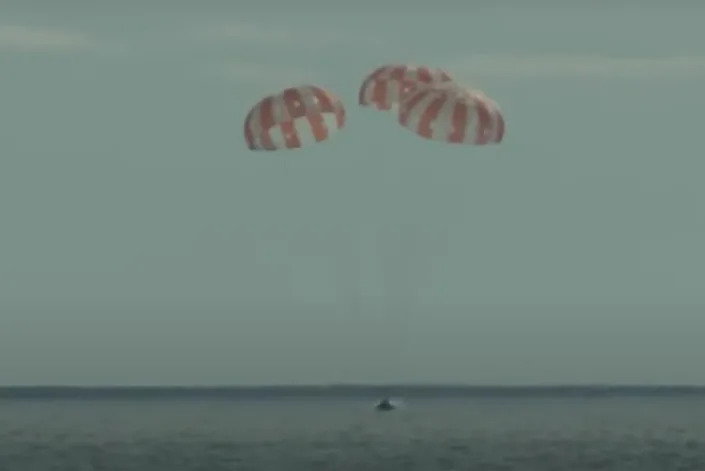Artemis 1: End of mission
The Orion spacecraft descends under its three main chutes, off the coast of Baja California. Credit - NASA
NASA picked a very good morning to return from the moon. It was 50 years ago today that the crew of Apollo 17 landed in the Taurus Littrow Valley on the lunar surface, where they planted the last of six flags Apollo crews would leave behind to mark their moments in history. Today, the space agency planted a new, if symbolic flag, when the Artemis 1 mission’s Orion crew capsule splashed down in the Pacific Ocean 320 km (200 mi.) off the coast of Baja California, Mexico, at 9:40 a.m. Pacific Time. The safe return marked the end of a 25-day lunar orbital mission, proving the flight-worthiness of the Orion spacecraft, which is expected to carry a crew of astronauts on a circumlunar journey during Artemis 2, in 2024.
“Splashdown,” NASA tweeted, seconds after the spacecraft hit the water. “After traveling 1.4 million miles through space, orbiting the Moon, and collecting data that will prepare us to send astronauts on future #Artemis missions, the @NASA_Orion spacecraft is home.
The recovery of Orion was expected to be smooth and without incident—“nominal,” as NASA puts these things. The Navy’s USS Portland was in the splashdown site—just 8 km (5 mi.) away; after the capsule hit the water, a five-hour process got underway in which a recovery team left the ship aboard small boats, headed for Orion. There, the plan calls for them to attach cables to the spacecraft and tow it back to the Portland, where, a winch line and four supporting cables were waiting to lift Orion up to the deck of the ship.
“Last week, we completed our final rehearsal with the USS Portland,” said Melissa Jones, NASA’s landing and recovery director, in a Dec. 5 statement. “We had a great three days working with them to refine our procedures and integrate our teams.”
The mission the spacecraft flew was an ambitious one, beginning with the Nov. 16 launch of NASA’s much-delayed Space Launch System (SLS) moon rocket—a machine that, with its 4 million kg (8.8 million lbs) of thrust, is the most powerful rocket ever launched. The Orion spacecraft took five days to reach the vicinity of the moon, then fired its engine to brake its speed slightly and enter lunar orbit. It spent the next two weeks making two wide, looping circuits around the moon, twice passing as close as 129 km (80 mi.) from the surface. At its most distant remove, the ship was more than 431,000 km (268,000 mi.) from Earth, and 69,000 km (43,000 mi.) above the far side of the moon. That broke the 400,000 km (250,000 mi.) distance record for a crew-rated spacecraft set by Apollo 13 during its one pass around the far side of the moon in 1970.

Comments
Post a Comment